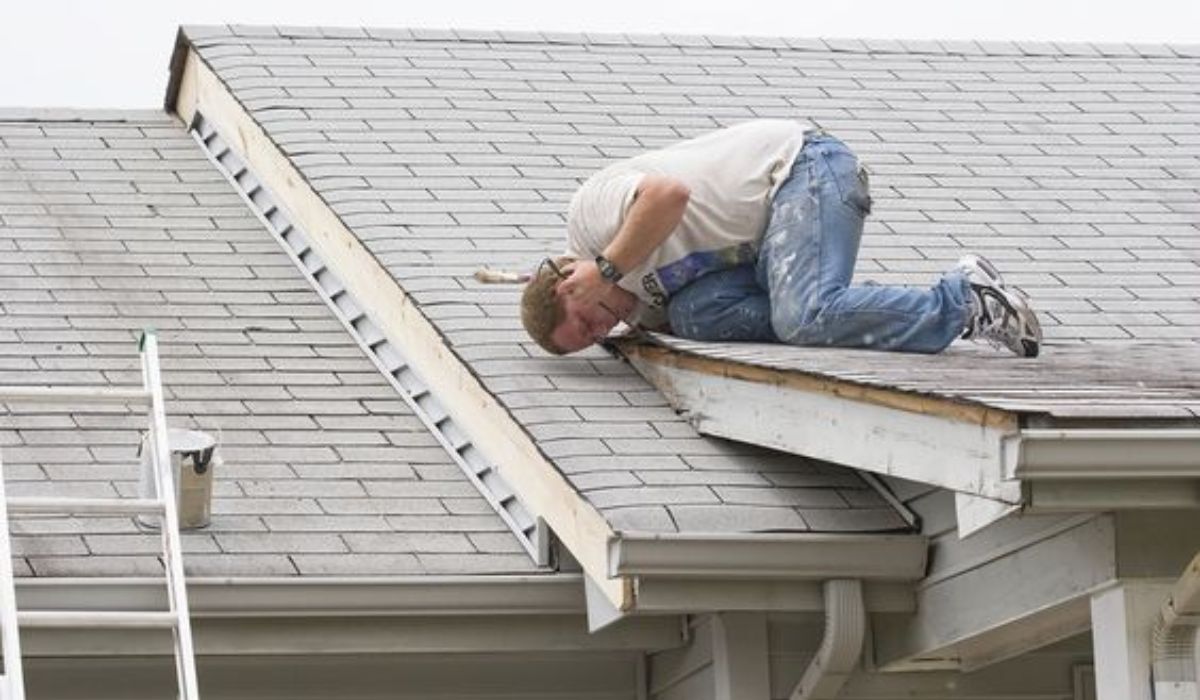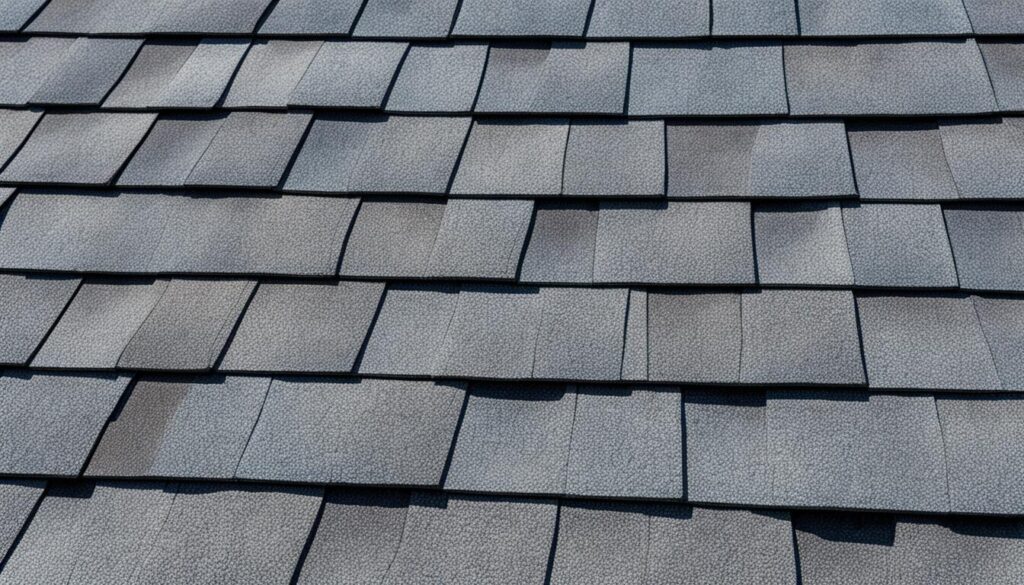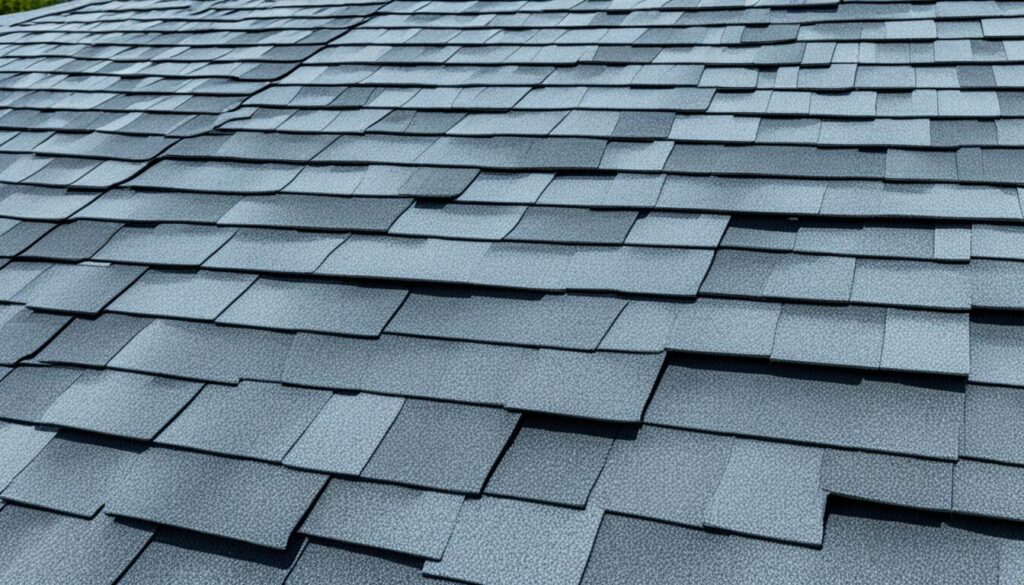
Getting a new roof is a big step to keep your home safe and sound. But what about ceiling damage after this big change? You might wonder how a new roof could cause problems with your ceilings.
The real issue might be bad installation. When roofers take shortcuts or miss important steps, it can cause leaks. These leaks can lead to water damage in your home’s ceiling. Recognizing a poorly done roof is important. Then, you can figure out how to deal with the damage.
Key Takeaways:
- Improper roof installation can cause ceiling damage after a roof replacement.
- Signs of a bad roof replacement include an uneven roof appearance and missing roofing components.
- Roofing contractors may be responsible for the cost of repairing ceiling damage.
- Consulting professionals and communicating with the roofing company are essential in resolving the issue effectively.
- Restoring your home’s interior after ceiling damage is possible with the right solutions and approach.
Why Do You Have Ceiling Damage After Your Roof Replacement?
Ceiling damage after a roof replacement? A leak is likely the culprit, showing the roof’s poor installation. The issue may come from a contractor’s shortcuts or lack of careful work. If you picked the cheapest option, the risk of a bad install goes up.
Remember, not all bad installs are on purpose. A good roof without leaks or damage is every homeowner’s expectation. Make sure to sort out leaks or other major issues with your contractor before they finish their job.
Seeing ceiling damage after a new roof was installed can be alarming. Often, it points to a leak, highlighting a faulty installation. This could happen if the contractor tries to save time or overlooks important steps. Choosing a budget-friendly option can make this problem more likely.
But, know that not every poor installation is intentional. A properly installed roof should protect your home without any leaks or damage.
If you spot ceiling damage post-replacement, addressing leaks with the contractor is key. This ensures they take action to fix the problem. A high-quality roof should keep your home safe and dry, not cause issues. Always bring up any problems right away with your contractor.
Is the Roofing Contractor Responsible for Ceiling Damage after Your Roof Replacement?
If your new roof leaks because it was installed incorrectly, the contractor should fix it. This is part of their promise, so they do the work for free. They also should pay for any damage to your ceiling caused by the leak. But, what they cover might be in the contract. Be careful, some contracts let contractors off the hook for inside damage. Choosing a trusted roofer ensures your roof and the ceiling will be repaired.

How Do You Know if You Got a Bad Roof Replacement?

Improper installation can lead to ceiling damage after a roof replacement. Signs of a bad job can be seen in various ways. Look out for a roof that appears uneven. This might show up as lifted shingles, bumps, or looking wavy. These problems often stem from not nailing the shingles properly or from unskilled work.
Finding missing parts from the replacement is another warning sign. Roofers sometimes omit things to cut costs, but this can cause leaks later on. If the new roof was put on without replacing damaged decking, that’s not good. And don’t forget about proper attic ventilation. Not addressing this can make your roof wear out much earlier than expected.
What Recourse Do You Have for a Bad Roof Replacement?
If you think you got a poor roof replacement, act promptly. Reach out to the contractor right away. Make use of the workmanship warranty. But, remember, not all contractors honor their warranty. If they don’t take responsibility, you have other paths to fix the issue. You should act fast, getting advice from experts can help.
Hiring an independent roofing inspector is a good move. They will check the roof’s quality and note any issues. The report they give you can help make your case stronger.
Another idea is to get a second opinion from a different roofing contractor. They will evaluate the roof and suggest what needs fixing. Sometimes, they uncover issues missed by the first contractor.
If the first contractor doesn’t fix the problem or admit fault, legal counsel might be needed. A lawyer who knows about construction law can help. They can advise on your options, like filing a complaint or demanding a settlement.

Keep records of all talks with the contractor. Save emails, letters, and notes. These may help your case or in court.
Dealing with a bad roof job takes time and effort. Look for advice and stand up for your rights as a homeowner. This way, you can repair your home’s integrity and safeguard your money.
Damage Caused by Roof Crew During Roof Replacement
Ceiling damage might happen during roof replacement due to the roof crew’s carelessness. They could slam materials on the roof, causing vibrations. This might create internal damage after roof replacement. You might notice nail pops and bubble shapes in the ceiling drywall.
Make sure to tell the roofing company about these issues. A rough roof job can create stress throughout the house, even in the basement. It’s crucial to have experts check the damage. Then, you can work with the roofing company to fix the problems.
Factors Contributing to Internal Damage after Roof Replacement
While replacing your roof, several things can cause damage inside your home. Knowing these can help figure out the damage’s source. This is key to finding out who’s responsible.
Pre-Existing Conditions
Damage inside could be due to problems that existed before. These might be sheetrock, spackle, or nails that were already loose. Even if the new roof should not make these issues worse, it’s smart to look at how the roof job impacts them.
“The presence of pre-existing conditions does not absolve the roofer of responsibility for any additional damage caused during the roof replacement process.”
Wet Roof Board Impact
A wet roof board can really harm your ceiling’s strength. It might make the sheetrock or plaster weak, causing more problems. Find out if a wet board led to your damage. Then, deal with it.
Responsibilities of the Roofer
Roofers are responsible for any inside damage caused by their work or neglect. Good roofers do their best to avoid causing harm. Speak with experts if you think the roofer is to blame. They can advise you on what to do next.
If there’s damage after getting a new roof, act fast. Collect evidence, detail the problems, and talk to all involved quickly. Getting advice from pros can really help when figuring out next steps.
Conclusion
It’s tough to find ceiling damage after getting a new roof. Yet, knowing why it happens and what to do helps. Ceiling harm often links to a bad installation, like skipping steps or not caring enough. The roofer must fix this and pay if it’s their fault.
If your roof looks off or some parts are missing, deal with it fast. Don’t hesitate to fix your roof’s inside after replacing it. Talking openly with the experts is vital for a smooth repair and a good-looking ceiling again.
Handling a roof leak quickly is vital to keep your home safe. If water damage is already there, don’t wait to act. Get professionals on board to stop the leak and make your ceiling like new. Quick decisions and the right help make restoration go well.

Meet William Adams, a seasoned roofing expert with over 30 years of hands-on experience in the industry. Having worked tirelessly under the scorching sun and through the fiercest storms, William brings a wealth of knowledge and expertise to the table. Hailing from the heart of the USA, he’s witnessed the evolution of roofing practices firsthand, mastering every aspect along the way. Now retired from the field, William spends his days cherishing time with his loved ones while sharing his invaluable insights through this platform. With William at the helm, you can trust that every tip, advice, and recommendation provided is backed by years of real-world experience and unwavering dedication to quality craftsmanship. Join us as we journey through the world of roofing, guided by the wisdom and passion of a true industry veteran.
